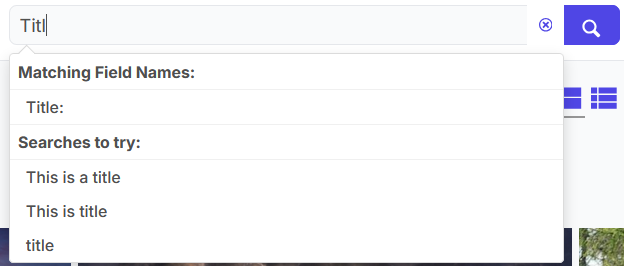There are three ways to search for files: quick search, categories, and filters. The search result can be narrowed down in all ways at the same time.
Note that active filters (quick search, categories, filters) are displayed in the search results bar of the user interface, where they can also be deactivated.

Quick search
The quick search is configured to search in the following fields (note that the fields in the quick search depend on the configuration and may differ from those mentioned in the instructions):
- Title
- Description
- Keywords
- Categories
- Person shown in the image
Search operators:
| Search operator | Description |
|---|---|
| Space-separated search terms | Processed as an AND search. This means that both words should be found in the file’s metadata. |
| Two vertical lines || | Processed as an OR search. This means that one of the words should be found in the file’s metadata. |
| Blank search | Finds all files with selected filters. |
| Search terms separated by a minus “-” sign | Searches for everything except those that contain the search term after the minus. |
| Clause with quotation marks ” ” | Treated as a single search term (phrase search). |
| Entry enclosed in semi-quotation marks ’ ’ | The search term is searched for exactly. |
Advanced quick search
In addition to the predefined quick search fields, the search can be focused to a specific metadata field. The syntax requires the name of the field before the : character, followed by the given lookup value. For example, we can search for all records where the Title contains the word “chair” using the search syntax Title: chair.

You can also use multiple search criteria by combining fields with either the AND (&&) or OR (||) search operator. We can expand the previous search to return only approved records, changing the search syntax to Title: chair && Status: Approved.

Real-time suggestion
The user interface makes it easy to enter field names by providing corresponding fields in real-time in a pop-up window.

Refining the search
Normally, when searching within a specified field, a contains search is used. For example, an advanced quick search for Title: chair will find all records where the Title field contains the word “chair.”
The search also supports flags that affect how the query is created. Flags are written in front of the : sign, which distinguishes the field from the search value.
Search operators and flags:
| Search | Flag | Description |
|---|---|---|
| Exact | = | To perform an exact search, use the = flag: Title =: Red chair returns records where the Title is exactly “Red chair”. |
| Does not include | ! | When you want the search results to not contain the certain records, use the ! flag: Title!: chair returns records where the Title does not contain the string “chair”. |
It is also possible to combine flags. For example, a quick search for Title !=: Red chair returns records where the value of the Title field is not exactly “Red chair”.
Hierarchical search
By clicking on the name of a hierarchical structure, you narrow the search result to include the files of that structure and its substructures. For example, in a category search, clicking on the name of a category will limit the search result to include the files of that category and its subcategories.

Filters
By activating a filter, you narrow down the search result to include files that meet that criterion, for example, files that are classified as images.

Filter choices adapt to the content available, and the filters available depend on the configuration of the service.
Similar content
You can easily search for similar content in the following ways:
- Using the magnifying glass: Click the magnifying glass after the contents of the metadata field. This will perform a search operation to search for matching content.
- Using categories and keywords: Click categories or keywords related to the content you’re looking for. This filters the content displayed and helps you quickly find what you’re looking for.


